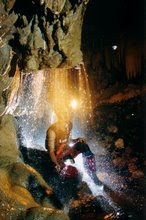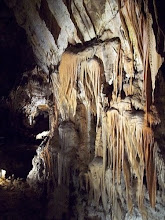Throughout South-East Asia Limestone is solely considered as an
important resource for mining. No other values are recognized by
geologist and mining engineers. The exclusive exploitation of
limestone by cement, steel, cosmetic, chalk, pharmaceutical and
industries and for agriculture and construction material, without
any consideration of environmental impact, even degradation, has
repeatedly proven to cause serious impact on biodiversity and
cultural property. Impact on the local population, from the socio
cultural, socioeconomic point of view and general health
condition is rarely assessed properly.
Especially the quarrying of limestone for cement, is rarely
adequately evaluated for its multi dimensional impact. Even
environmental assessments for cement factories generally fail to
take into account some of the unique biological, cultural, scenic
and scientific features of limestone.
BIODIVERSITY
The biodiversity of limestone ecosystems, including karst and
cave systems, is highly characteristic and restricted, comprising
species which are able to cope with the abundance of calcium,
species that can endure the exceedingly dry soil conditions over
part of the year, or species which are confined or primarily found
in limestone caves. Some endemic species are even confined to
single hills or cave systems.
But the most valuable creatures within a karst system in south
East Asia, dwelling in caves are the bats and swiftlets. They are
profoundly important in maintaining the ecological balance of
the limestone and surrounding non-limestone areas. Bats in
Southeast Asia, are either insect eating, consuming huge
quantities of insects daily, nectar sucking - hence the sole
pollinators of commercial tree crops yielding many edible and
highly priced fruits, and pollinators of various timber trees, or
fruit eating, dispersing the undigested seeds. Cave-swiftlets
species are insect eating and some species are producers of
delicaciespriced as much as US$ 2000. - per kilogram.
Many of the species are relatively small, little known, and are
rarely included in the lists of protected species in South East
Asian countries, which tend to focus on the larger and more
obvious species, like the Maleo bird for instance.
Maros karst and caves have been visited by some experts in
Biospeleology from France since 1987. Numerous publications
on the biodiversity of its caves prove that the prevalence of
important endemic Maros cave biota has highly scientific value.
They have even found troglobites - hitherto unknown cave
adapted species, denouncing the general scientific opinion that
tropical caves do not create suitable conditions to develop new
species, completely isolated from their surface relatives.
Limestone biodiversity is considered unique, because limestone
areas are unusually rich in species many of which have very
small ranges and display extraordinary adaptations to the
limestone habitats. Cave dwellers, living in total darkness, have
lost colour and eyesight, but have developed a wide range of
adaptations to the eternal darkness.
Limestone biodiversity is extremely vulnerable to disturbance
because species adapted to extreme habitats are not able in most
cases to survive outside of their habitat. Species with a restricted
environmental range can easily become extinct. Like 7 species
of butterflies in Maros, in 1999 considered extinct by experts.
Cave species found in a single cave system or snails, found on a
single limestone hill often occur in small numbers per species.
Hence, the loss of only a few individuals can mean a significant
loss to the species as a whole.
Pollution of underground rivers by waste disposal and pollutants
repeatedly causes the extinction of specific cave aqua fauna. The
use of pesticides in agro culture in karst areas and the subsequent
development of insects resistant to these pesticides (resistent
biotypes) cause insect eating bats and swiftlets to die from
intoxication or to produce guano containing these toxic
chemicals, which in turn disrupt the established guano micro-
ecosystems in many caves.
Limestone areas have arthropod communities which, if
undisturbed, act as a buffer against pest outbreaks in surrounding
agricultural land.
Fish, molluscs, bats and certain plants in limestone areas serve as
a source of food to the local people. Some plants are collected for
medicinal purposes.
Many endemic trees have highly economic value, like teak
(Tectona grandis), Mahogany (Swietenia mahagony), sandalwood
(Santalum album) and many unknown species.
CULTURAL HERITAGE
Many caves in Maros limestone area depict prehistoric hand
drawings, which proves that caves were known to prehistoric
man, serving as shelter and chosen location to exhibit their skill
of rock art. Many caves also contain archaeological remains or
artifacts like prehistoric tools, weapons and potteries.
CLIMATE
Although frequently and eloquently denied by investors, climatic
change will certainly take place, if quarrying prominent
limestone hills or escarpments, functioning as natural wind
barriers, are not restricted. The case of quarrying karst hills at
the small island of Nusakambangan for cement, which draws
protest from nearby Cilacap town inhabitants, so strongly denied
by the conglomerate investor recently, should urgently be
considered.
The strong winds blowing from the Indian Ocean towards the
South Coast of Java, hence afflicting Cilacap, a town harbor
north of Nusakambangan, protected by its limestone hills, will
certainly influence the local microclimate. Maros hills, when
quarried extensively, will also influence South Sulawesi interior.
This should be thoroughly assessed by climatologists.
THREATS TO LIMESTONE AREAS
BY QUARRYING:
Negative impact on Biodiversity
Changes in hydrological systems.
Pollution by dust, silt and other industrial effluents. Destruction
of prehistoric sites,
Displacement of local people.
Deforestation. Extinction of primary forest.
BY UNCONTROLLED BIRD’S NEST HARVESTING
BY UNCONTROLLED EXPLOITATION FOR TOURISM
BY OVERHARVESTING OF COMMERCIALL
VALUABLE PLANT SPECIES.
IMPACT OF DISTURBANCE
1. Impoverishment of the local biodiversity.
2. Extinction of certain species
3. Destruction of key environments like unique geomorphology
(Tower karst in Maros)
4. Destruction of archaeological and cultural sites.
5. Reduction of the economic value of limestone areas, other
than the value of the amount of rock or ore that has been
extracted.
6. Extinction of scenic landscapes.
MANAGEMENT OPTIONS
1. A careful selection of sites of exploitation, so that damage to
the biodiversity and cultural and archeological remnants in
minimized.
2. Value assessments of potential sites as well as the region in
which sites are located. Value assessments should be
perform by an independent of specialists. Hydrological and
Speleological assessment is of prime importance.
3. Comprehensive plan to reduce the impact on the
surroundings of the quarry during its exploitation, with
implementation of regular monitoring methods.
4. Removal of machinery, buildings, stores and wreckage
after the exploitation of the Quarry. Reshaping and
replanting the exploited site to obliterate the quarry to
facilitate regeneration of a vegetation cover, with
regular monitoring of the results.
RECOMMENDATION TO KARST EXPLOITATION
1. Limestone areas in which no karst features have
developed, or limestone bedrock below alluvial
sediments, or occurrences of dolomitic limestone
should be selected for exploitation wherever possible.
2. Selection of isolated limestone hill (remote from other
limestone hills) should be avoided.
3. Preferably, an exploitation site should be located in the
largest limestone area. The site should never extend
over the entire area, but always leave a substantial part
of it untouched.
4. Within a large area, the exploitation of a number of
small quarries throughout the area.
5. Sites with numerous caves should be avoided.
6. Limestone bodies riddled with small voids (millimeters to
centimeters wide) should be avoided.
7. Sites in areas with underground streams and springs should
be avoided.
8. Wherever there are cave dwelling bats and swiftlets, no
quarrying are allowed in a range of 45 km from their habitat.
This also valid for karst areas inhibited by protected animals
like the Sumatran Tiger, Bear, Elephant and many endagered
bird species (e.g. the Bahorok karst area with cave dwelling
bats pollinating the famous durian and rambutan fruit
exported to neighbouring countries as well. Also still
inhabited by above mentioned protected animals)
9. Unique geomorphological features, not found or rarely seen
anywhere else in the world should never be quarried (e.g.
Cockpit karst south of Gombong, Tower karst at Maros. The
"thousand hills" or conical karst at the Gunung Sewu karst
region, all of which have extremely high scientific
significance from the geodiversity point of View.
10. Karst areas near large villages or towns, heavily populated,
are excluded from Quarrying.
11. Only the DRY METHOD of cement industries should be
recommended. The WET METHOD using up tremendous
amounts of water, so needed by the local people and
agriculture, and producing three times the amount of C02
emission in comparison with the dry method, should be
banned. The WET METHOD is also highly inefficient in the
long run. The DRY METHOD, needing more funds to invest
is more efficient and does not need an excess of water.
Pollution trading under the Kyoto Protocol should be
encouraged.
12. No cement industry should be recommended if the sole
motivation is to limit the amount of investment by
choosing sites where the infrastructure is available
(roads, railway stations, ports etc), since pollution and
overuse always result in destruction of these
infrastructures.
13. Limestone quarrying near National Parks, Nature
Reserves, should be prohibited
14. Enough funds should be deposited by the mining
companies to guarantee post mining relandscaping and
replanting.
In January 1999, the International union on the Conservation of
Nature, the UNESCO and Worldbank, co-sponsored by the
largest Cement Industry at Thailand, have organized an
international meeting to concoct guidelines in management of
limestone resources. In September 1999, specialists in many
karst environment related fields have published a very
comprehensive book, entitled: BIODIVERSITY AND
CULTURAL PROPERTY IN THE MANAGEMENT OF
LIMESTONE RESOURCES (ISBN 0-8213-4508-7)
The scientists contributing to this book are: Wim Bergmans
(chyropterologist), Geoflfey Davison (snail specialist) Louis
Deharveng (biospeleologist) Ian Glover (archaeologist) Guido
Keijl (chyropterologist) Ruth Kiew (flowering plants specialist)
Maurice Kottelat (ichthyologist) Willem Meijer (mosses and
algae specialist) George Strong (geologist) Jaap Veemeulen
(snail specialist, botanist and geologist) Robby Ko (speleologist
and cave tourism consultant) John Gunn (post quarrying
relandscaping specialist) Elery Hamilton Smith (karst and cave
conservation specialist) Frank Howard (chyropterologist)
Barbara French (chyropterologist) Lim Chan Koon
(ornithologist) Dean Smarst (karst dendrologist)) Alexander
Monastyrskii (lepidopterist)









